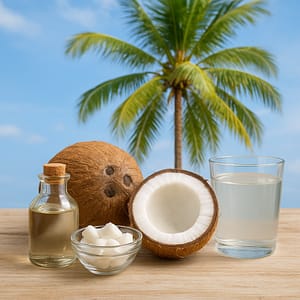- Home
- Coconut

I. General Information
A. Scientific Name:
Cocos nucifera
B. Alternative Names:
Coco, Niu, Niyog, Copra (dried meat), Kalpavriksha (“Tree of Life”)
C. Pronunciation:
KOH-ko-nut
II. Sourcing and Origin
A. Source:
Coconut palm tree (Cocos nucifera) produces the large, fibrous drupe (commonly called coconut).
B. Geographic Origin:
Believed to have originated in the Indo-Pacific region, particularly along the coasts of Southeast Asia and the islands between the Indian and Pacific Oceans. Now widely cultivated in tropical regions around the world.
C. Method of Processing:
Coconut water is extracted directly from the green fruit.
Coconut meat (kernel) is dried (copra) and pressed to yield coconut oil.
Coconut milk/cream is made by blending grated fresh meat with water and straining.
Coconut shell & husk are processed into charcoal, coir fiber, and household products.
III. Properties and Uses
A. Physical Properties:
Appearance: Brown, fibrous outer husk; hard woody shell; white, edible flesh; clear coconut water inside.
Texture: Smooth liquid (water, oil), creamy (milk/cream), coarse (copra, coir fiber).
Aroma: Mild, sweet, nutty fragrance.
B. Chemical Composition:
Coconut water: Electrolytes (potassium, sodium, magnesium, calcium), natural sugars.
Coconut meat: Medium-chain fatty acids (lauric acid, capric acid, caprylic acid), fiber, protein, iron.
Coconut oil: Predominantly saturated fats (MCTs – medium-chain triglycerides).
C. Primary Uses:
Skincare: Moisturizer, natural makeup remover, soothing balm for dryness and irritation.
Haircare: Conditioning oil, anti-frizz treatment, scalp nourisher.
Wellness: Hydration (coconut water), energy support, antimicrobial benefits.
Culinary: Cooking oil, dairy substitute (milk/cream), flour, sweeteners (sugar, nectar).
Household: Natural cleaning polish, soap-making, coir brushes, bowls/utensils from shells.
D. Key Benefits:
Deeply hydrates skin and hair.
Natural source of electrolytes for hydration.
Supports heart and brain health via MCTs.
Antimicrobial and antifungal properties.
Zero-waste: every part of the coconut is usable.
IV. Safety and Considerations
A. Potential Allergies:
Rare, but coconut allergies exist (skin irritation, digestive upset).
Some individuals sensitive to tree nuts may also react to coconut (though classified differently).
B. Best Practices for Use:
Use virgin, cold-pressed coconut oil for skincare and cooking.
Store coconut products in cool, dry conditions to prevent rancidity.
For hair masks, apply oil sparingly to avoid greasiness.
Drink fresh coconut water within hours of opening.
C. Special Precautions:
Excessive consumption of coconut oil may raise cholesterol levels in some individuals.
Coconut water is high in potassium, consult a doctor if you have kidney issues.
Always patch-test coconut oil on skin before widespread use.
V. Fun & Educational Facts
A. Historical Context:
Coconut has been called the “Tree of Life” in South and Southeast Asia for centuries, sustaining communities with food, water, shelter, and materials. It was carried by seafarers across oceans as both nourishment and a trade commodity. In Ayurveda and traditional Pacific Island medicine, coconut oil and water were used for healing, hydration, and rituals.
B. Did You Know?
A coconut is not a nut, it’s a drupe (a fruit with a hard stone covering the seed).
Coconut water was used as a natural IV fluid substitute during WWII due to its sterile, electrolyte-rich composition.
The longest recorded coconut palm lived for over 100 years.
C. DIY Recipe Idea:
🥥 Coconut Energy Bites
1 cup shredded coconut
½ cup rolled oats
3 tbsp coconut oil
2 tbsp honey or maple syrup
Mix, roll into balls, refrigerate, and enjoy!
🥥 DIY Coconut Hair Mask
2 tbsp coconut oil
1 tbsp honey
Warm slightly, apply to hair, leave 20 minutes, rinse with mild shampoo.
🥥 Coconut Curry
Coconut milk forms the creamy base of many Thai, Indian, and Filipino curries. Combine with vegetables, protein, and spices for a rich, comforting dish.
